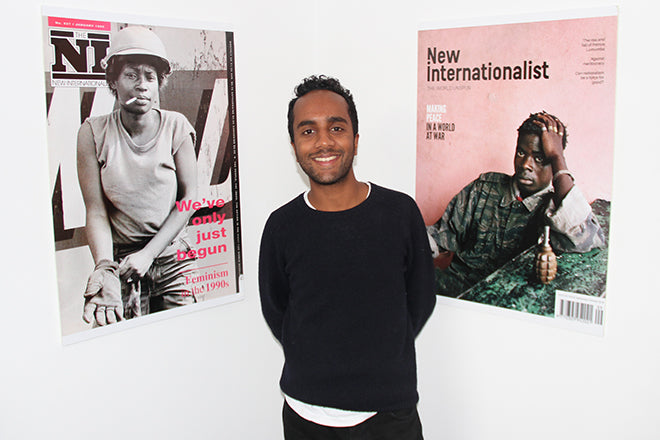
Yohann Koshy, Co-editor, New Internationalist
The New Internationalist launched in 1973 as a campaigning monthly covering the growing western interest in and concern for the developing world. Today it positions itself as a fiercely independent, co-operatively owned organisation dedicated to socially responsible journalism. We meet one of its co-editors, Yohann Koshy, and hear about the magazine’s recent redesign and his first visit to a printing press.
Tell us about your typical Monday journey to work
After almost always sleeping past my alarm, I start the morning by turning on the Today programme on Radio 4 and then turning it off in anger, as John Humphreys conducts a reverential interview with Tony Blair or Henry Kissinger or some other war criminal. I get on my bike around 8.45am. My journey takes me off Osney Island, which is near Oxford train station, through the town centre, arriving at our Cowley road office just after 9am. Morning stimulation, therefore, consists of dodging commuters.

Describe the state of your desk and what you can see in your office
State is the right word. There’s a pile of review copies teetering precariously on the top-left edge. A near dead Lidl cactus that I received in the office Secret Santa. There’s my planner, business cards, old issues of the magazine, and lots of post-it notes.
From my desk, I can see the rest of the editorial team, the newsstand where our subscriptions to other magazines like New Scientist and The Economist are kept, and the top of a bar that appears to have been named after David Cameron’s failed civil society project from the early 2010s: Big Society. (I’ve just been told the name is a coincidence.)
Which magazine do you first remember?
Does The Beano count? I loved strips like the Numbskulls and The Bash Street Kids.
Which magazine matters to you the most right now?
Viewpoint Magazine has proved useful for my research for the March-April 2019 issue of New Internationalist, which is focused on anti-imperialism. I subscribe to New Left Review, Bookforum and the London Review of Books, which are always good company on long train journeys.
Your magazine is run as a co-operative; please explain what this means for employees and for the project as a whole
This means there are no bosses, and important decisions are made democratically. We’re divided into groups (Editorial, Books, Mail Order etc.), who meet fortnightly in a co-op meeting. Each group presents on figures and what they’re up to. One of the nice things about co-operatives is the transparency. I used to work at a hierarchical new media company, and there were always random higher-ups, ‘executives’ and ‘directors’, sauntering about the office and you’d just think, “What do they actually do?” In terms of the project as a whole, I think it makes us more appealing to readers: they know they’re dealing with people who practise what they preach.
New Internationalist is a campaigning project; how do you measure success?
Well, we’re not an NGO or campaigning organisation as such. But our charter does have an editorial policy, which, to partially quote it, requires us to “report on issues of world poverty and inequality, to focus attention on the unjust relationship between the powerful and powerless in both rich and poor countries”. If we’re sticking to that then we’re successful.

What was the thinking behind your recent redesign, and how did you select TCO as your design consultant?
The magazine needed a facelift. When I joined a year ago I remember looking at old issues from the seventies and thinking how well the clean, modernist aesthetic had aged. So, we asked TCO to synthesise the classic style with new design trends. We chose TCO because they were really enthusiastic about the project and got what we were about. They also, incidentally, had a venue that we used for the launch party. They were great to work with and the finished product is excellent.
What did you learn from the first redesigned issue on that helped you improve and adapt the second?
Legibility turned out to be a problem for older readers whenever text was on-top of a colour-tinted background, so we toned down the tints for issue two. The black colour of the masthead on the front page was also slightly washed out, so we corrected that. We’re working with a new type of uncoated paper, which absorbs ink in a way the previous didn’t and makes photographs come out darker than they appear on a screen.
One of the most interesting aspects, for me, as someone who had experience only in digital journalism, was visiting the printing press when the second issue was being printed: checking it as it ran out and deciding whether to change the balance of colours accordingly.
What’s going to be the highlight of the week for you?
I saw that former Black Panther Bob Brown is giving a talk on Friday about Kwame Nkrumah at the university, which I’ll try to go to. So that might end up being the highlight.
What will you be doing after this chat?
Going to have an Ethiopian meal for lunch with my colleagues at the Gloucester Green food market. I haven’t been before, but Hazel Healy, a co-editor who grew up in Ethiopia, says it’s the best, or perhaps only, place for it in town.
Editors: Vanessa Baird, Kelsi Farrington, Dinyar Godrej, Hazel Healy, Thomas Kilroy, Yohann Koshy, Chris Spannos, Jamie Kelsey-Fry, Husna Rizvi








